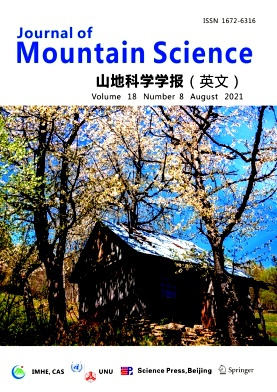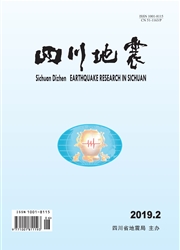
Journal of Mountain Science投稿地址
Journal of Mountain Science詳細(xì)信息
Journal of Mountain Science
Journal of Mountain Science
Journal of Mountain Science投稿要求
Journal of Mountain Science雜志投稿須知:Author informationThe authors should provide the following information for all authors when submitting a paper: author names, institutions, mailing addresses, email addresses, and research interest. Each letter of the family names of all authors should be capitalized. AuthorshipAuthorship of articles is hugely important in academic careers as it is used to measure research productivity and as the basis for decisions on appointments, promotions, tenure and funding.The authorship of academic papers should reflect who did the work. Papers submitted to the JMS should follow these rules:
1、 A person who has not made a sufficient contribution to the work should not be included in the authors.。
2、 A person who has contributed substantially should be included in the authors.。
3、 If there are two or more authors, the corresponding author should be assigned. The first author will be taken as the corresponding author when no corresponding author is assigned.。
4、 All authors must sign to consent the submission.A cover letter with signature by all authors is required when the manuscript is submitted. 。
5、The author list and the author sequence should be fixed before submission. Requests to add or delete authors at revision stage or after submission can only be considered after receipt of written approval from all original authors and a detailed explanation from the corresponding author about the role/deletion of the new/deleted author (s). Once an authorship dispute arises before publication, the process should be halted until the dispute is resolved. Changes of authorship or in the order of authors are not accepted after acceptance of a manuscript.Figures and Tables The Copyright and License Policies that apply to articles also apply to figures. Please do not submit any figures, photos, or tables that have been previously copyrighted unless you have and can supply written permission from the copyright holder to publish under the CC-BY or CC0 license. Without this, we cannot publish the figures.Figures (photographs, graphs and diagram) should be in high quality, and in TIFF format. The TIFF figures should be saved at a minimum resolution of 600 dpi (dots per inch) at final size. TIFF file, especially those containing color, should be large. We encourage authors to provide color figures. Figure legends should be related to figures or plates, and they should be placed outside the figures or plates, NOT inside. The size of all letters and symbols should be appropriately fitting figures. The plate number and author's (photographer) name should be placed below or beside plates. Words in the figures must be in Times New Roman. Suggested figure sizes are 7-8 cm or 14-16 cm at width with font size at 8-9 point.Tables should be editable in Microsoft Word easily, i.e., they should NOT be in picture format. Table titles should be concise and exactly to explain what the table shows.ReferencesThe references are listed by the "author-publishing year" system. When a reference is cited in the text, the author(s) name(s) should be given if there are one or two authors (Zhang and Li 2009). If there are more than two authors, et al. is added after the first author. The year of publication should be indicated after the author(s) name(s)( Zhang et al. 2000). If a same author has more than one paper cited in one year, a, b, c … should be added after year of publication (Guo 2001a). When two or more references are cited in the same place in the text, ";" should be added between them (Zhang et al. 2000; Guo 2001a).References after the text (cited list) should be a list of all the sources used in your paper, and arranged alphabetically by author's last name (family name), or when there is no author, by the first word of the title (except A, An or The). The author name should be written in the form of family name (written in full) first and then the initials (the capitalized first letter of the given name). The year of publication, the volume number of journals, the page range, the place of publication and the name of the publisher for each book cited should be provided in the references. For Non-English publication, the language should be marked at the end. All the items in reference should be shown as complete unabbreviated source citation except for author's name. All the listed references should be cited in the text.For journal articles,Doi should be added at the end of each item of reference if they have ones. Please refer to the following examples for the reference.1、 Book or monographShrestha TB, Joshi RM (1996) Rare, endemic and endangered plants of Nepal. Kathmandu: WWF, Nepal Program. p 244、Hao F, Quan J, Yang ZS, et al. (2000) Land Resources of Yunnan, Kunming, China. Yunnan Science and Technology Press. pp 60-62、 (In Chinese)2、 ThesisDeConto RM (1996) Late Cretaceous Climate, Vegetation, and Ocean Interactions: an Earth System Approach to Modeling an Extreme Climate. PhD thesis, University of Colorado, Boulder, Colorado. p 10.3、 Paper from a proceedings or monographSmaling EMA, Nandwa SS, Janssen BH (1997) Soil fertility in Africa is at stake. In: Buresh RJ et al. (eds.), Replenishing Soil Fertility in Africa. SSSA Special Publication No. 51、 Wisconsin, USA. pp 47-61、4、 Paper from a serial publicationKuhle M, Kuhle S (2010) Review on dating methods: numerical dating in the quaternary geology of high Asia. Journal of Mountain Science 7: 105-122、DOI: 10.1007/s11629-010-1116-1Cui P, Hu KH, Zhuang JQ, et al. (2011) Debris flow discharge calculation and inundation simulation. Journal of Mountain Science 8: 1-9.DOI: 10.1007/s11629-011-2040-8
Journal of Mountain Science雜志簡(jiǎn)介
《Journal of Mountain Science》是由中國(guó)科學(xué)院主管,中國(guó)科學(xué)院·水利部成都山地災(zāi)害與環(huán)境研究所主辦的國(guó)際性全英文期刊。主辦單位中國(guó)科學(xué)院·水利部成都山地災(zāi)害與環(huán)境研究所是我國(guó)唯一專門從事山地研究的科研機(jī)構(gòu)。
《Journal of Mountain Science》主要發(fā)表在自然條件和人類活動(dòng)影響下山地環(huán)境演變與可持續(xù)發(fā)展的研究論文和知名專家的綜述性文章,選題范圍主要包括應(yīng)對(duì)氣候變化背景下的山地科學(xué)研究、山地環(huán)境演變及其與人類活動(dòng)的關(guān)系,山地生態(tài)系統(tǒng)退化與修復(fù),以泥石流、滑坡、土壤侵蝕為重點(diǎn)的山地災(zāi)害的動(dòng)力過(guò)程及防治理論和技術(shù),山區(qū)流域管理與開(kāi)發(fā)治理,山區(qū)特色資源保護(hù)和開(kāi)發(fā),山區(qū)文化多樣性和民族經(jīng)濟(jì)發(fā)展,山區(qū)少數(shù)民族問(wèn)題與居民福利等。
Journal of Mountain Science統(tǒng)計(jì)分析
影響因子:指該期刊近兩年文獻(xiàn)的平均被引用率,即該期刊前兩年論文在評(píng)價(jià)當(dāng)年每篇論文被引用的平均次數(shù)
被引半衰期:衡量期刊老化速度快慢的一種指標(biāo),指某一期刊論文在某年被引用的全部次數(shù)中,較新的一半被引論文刊載的時(shí)間跨度
他引率:期刊被他刊引用的次數(shù)占該刊總被引次數(shù)的比例用以測(cè)度某期刊學(xué)術(shù)交流的廣度、專業(yè)面的寬窄以及學(xué)科的交叉程度
引用半衰期:指某種期刊在某年中所引用的全部參考文獻(xiàn)中較新的一半是在最近多少年時(shí)段內(nèi)刊載的
平均引文數(shù):在給定的時(shí)間內(nèi),期刊篇均參考文獻(xiàn)量,用以測(cè)度期刊的平均引文水平,考察期刊吸收信息的能力以及科學(xué)交流程度的高低
熱門評(píng)論
感覺(jué)Journal of Mountain Science雜志快成我們專業(yè)的灌水雜志了,不過(guò)編輯老師很負(fù)責(zé),親自打電話過(guò)來(lái)詢問(wèn)一個(gè)表格的問(wèn)題。如果不是急著畢業(yè),建議只要有一點(diǎn)創(chuàng)新性的文章,還是往其他雜志投吧!
投了1篇,審稿一個(gè)月,只有一個(gè)審稿人提了點(diǎn)小意見(jiàn),不過(guò)我拖了很久才修回,修回應(yīng)該不到一個(gè)月就接收了,速度還是很快的。總的來(lái)說(shuō),認(rèn)真修改評(píng)審意見(jiàn),一定要非常認(rèn)真,一條條修改,回答評(píng)審的意見(jiàn)。中的幾率非常大。
10月24號(hào)投的稿,編輯部回信說(shuō)“40天內(nèi)不采用的稿件郵件通知”,到了第四十二天,沒(méi)收到任何消息,發(fā)郵件去查詢了一下,以下是編輯回復(fù)內(nèi)容“ 您好!專家審查認(rèn)為,您的稿件×××××有一定的意義,本刊擬采用。關(guān)于稿件的事項(xiàng),大約3周后我們會(huì)再與您聯(lián)系(我們按照來(lái)稿日期處理稿件)。”呵呵,效率很高的喲。
.10.7網(wǎng)上投稿,11.22初審結(jié)束,外審一個(gè)11.24完成,灰常快,一個(gè)11.24完成,11.27退修,12.4完成,12.16完成復(fù)審,12.20完成退修,12.21現(xiàn)在編輯加工了,基本上就是接受,感覺(jué)外審提的意見(jiàn)很中肯,編輯老師也很認(rèn)真,只要自己認(rèn)真答復(fù)外審和編輯的問(wèn)題,應(yīng)該都能收。
編輯說(shuō)的是審稿一個(gè)半月,基本上也差不多,快一個(gè)半月的時(shí)候返回的審稿意見(jiàn),修改后大概二十天左右就返回了通知。感覺(jué)還是挺快的。第一篇就這么順利的被錄用了,感覺(jué)還是挺高興的。
Journal of Mountain Science雜志權(quán)威度很高,同事也有在上面文章,里面文章質(zhì)量都很好,讓人受益匪淺,這個(gè)網(wǎng)站物流很快,賣家態(tài)度很好,寶貝的印刷很清晰。
Journal of Mountain Science編輯處理速度很快,而且人也相當(dāng)nice,外審也相當(dāng)快,建議投稿!初審,外審,主編終審速度非常快,到了編輯加工后就慢了,可能是因?yàn)橥陡鍞?shù)量多的緣故,編輯部老師非常好。初次投稿,有幸被中!
Journal of Mountain Science雜志審稿速度還可以,流程很是規(guī)范,非常感謝編輯,你們辛勤而認(rèn)真的工作態(tài)度,超贊的。總體來(lái)說(shuō)審稿速度還是比較快的,只要文章比較全面,有創(chuàng)新點(diǎn),一般都有機(jī)會(huì)中的。
我的稿件中間修改了1次,修好后5天就接受了,接著15天就讓簽訂版權(quán)轉(zhuǎn)讓協(xié)議,到第20天的時(shí)候就在線出版了,編輯很給力,個(gè)人感覺(jué)比較幸運(yùn)吧,現(xiàn)在這個(gè)雜志的系統(tǒng)加了在線。所以現(xiàn)在這個(gè)雜志不好中了。
Journal of Mountain Science的專審意見(jiàn)很鮮明,第一次專審給了兩條意見(jiàn),很中肯。編輯對(duì)文章的排版要求高,后邊兩次返修都是改格式。修改后錄用,推薦投稿!!
相關(guān)問(wèn)題
- Journal of Mountain Science是正規(guī)期刊嗎?
- Journal of Mountain Science是什么級(jí)別的期刊?是核心期刊嗎?
- Journal of Mountain Science評(píng)職稱可以嗎?單位認(rèn)可嗎?
- Journal of Mountain Science是北大核心嗎?是中文核心嗎?
- Journal of Mountain Science是科技核心嗎?
- Journal of Mountain Science是統(tǒng)計(jì)源核心嗎?
- Journal of Mountain Science是南大核心CSSCI嗎?
- Journal of Mountain Science是CSCD期刊嗎?
- Journal of Mountain Science是國(guó)家級(jí)期刊嗎?
- Journal of Mountain Science是SCD期刊嗎?
- Journal of Mountain Science是國(guó)家新聞出版署第一批、第二批學(xué)術(shù)期刊嗎?
- Journal of Mountain Science好投嗎?Journal of Mountain Science簡(jiǎn)介
相關(guān)期刊
更多常見(jiàn)問(wèn)題
| Q:論文發(fā)表的時(shí)候可以一稿多投嗎? |
| A:一稿多投的行為是典型的學(xué)術(shù)不端的行為,是國(guó)內(nèi)外學(xué)術(shù)界都明令禁止的行為,原因主要在于涉及到文章版權(quán)歸屬的問(wèn)題,如果作者的文章已經(jīng)被某個(gè)雜志社錄用,或者同時(shí)被兩家雜志社錄用,就會(huì)涉及到版權(quán)糾紛,作為雜志社都會(huì)保護(hù)本社的合法權(quán)益,到這時(shí)作者就會(huì)比較麻煩,吃官司都是小事兒了,被打入黑名單降級(jí)降職影響可就太大了。 |
| Q:職稱論文發(fā)表對(duì)時(shí)間有限制嗎? |
| A:職稱論文發(fā)表并沒(méi)有明確規(guī)定截止時(shí)間,需要作者結(jié)合自己所在地區(qū)的具體規(guī)定自己安排發(fā)表時(shí)間,一般職稱評(píng)審,各地區(qū)都會(huì)明確規(guī)定申報(bào)材料的最后期限和截止日期,我們結(jié)合這個(gè)日期來(lái)考慮何時(shí)發(fā)表文章就可以,大部分地區(qū)職稱評(píng)審都集中在每年的8-10月之間,有的地區(qū)要求7月中旬開(kāi)始交材料,最晚8月底之前,有的則是要求8月中旬交,還有部分地區(qū)要求截止時(shí)間為申報(bào)時(shí)間上年的12月31日,所以,各個(gè)地區(qū)的具體要求并不同,申報(bào)者需要在提交材料前確保自己的文章已經(jīng)見(jiàn)刊并且被相應(yīng)的數(shù)據(jù)庫(kù)檢索即可。 |
| Q:網(wǎng)上發(fā)表論文如何防騙?可靠網(wǎng)站與可疑網(wǎng)站如何區(qū)分? |
| A:由于發(fā)表論文的需求遠(yuǎn)遠(yuǎn)多于雜志版面的供應(yīng),再加上眾所周知的審稿難!審稿慢!選擇論文發(fā)表網(wǎng)站發(fā)表表論文確實(shí)能解決以上問(wèn)題。賣方市場(chǎng)的出現(xiàn)加之發(fā)表論文的剛性需求,就導(dǎo)致出現(xiàn)先付款后發(fā)表的現(xiàn)狀。論文發(fā)表網(wǎng)站正規(guī)與否是通過(guò)網(wǎng)站從始至終所提供服務(wù)體現(xiàn)出來(lái)的,任何交易只要存在時(shí)間差都會(huì)有風(fēng)險(xiǎn),但這個(gè)風(fēng)險(xiǎn)是可以通過(guò)您的智慧來(lái)避免的。因?yàn)椴皇撬姓撐木W(wǎng)站都是騙子,你要做的就是過(guò)濾掉沒(méi)保障的網(wǎng)站,選擇可靠的論文發(fā)表網(wǎng)站! |
| Q:一般期刊需要提前多久準(zhǔn)備? |
| A:省級(jí)、國(guó)家級(jí)期刊建議至少提前6個(gè)月準(zhǔn)備。一般來(lái)講,雜志社為了確保每期雜志正常出刊,都會(huì)提前將當(dāng)期之后1-3個(gè)月的稿件提前安排好,而一些創(chuàng)刊較早,認(rèn)可度更高的熱門期刊,來(lái)稿量較大,發(fā)表周期可能就會(huì)更久。提前準(zhǔn)備,意味著雜志的可選擇性更多。 |
| Q:核心期刊需要提前多久準(zhǔn)備? |
| A:核心期刊建議至少提前12個(gè)月準(zhǔn)備,核心期刊正常的審稿周期為1-3個(gè)月,且審核嚴(yán)格,退稿、返修幾率更大,這意味著在流程上耗費(fèi)的時(shí)間更久,且核心期刊版面有限,投稿競(jìng)爭(zhēng)更加激烈,即使被錄用,排刊也比普通期刊晚很多,因此需要更早準(zhǔn)備。 |

造與成礦學(xué).jpg)


科學(xué).jpg)
地質(zhì).jpg)
于我們.jpeg)